Pietro Gaietto
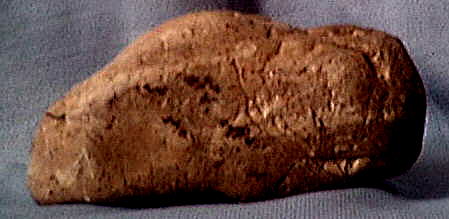
It represents a human head (left) joined at the neck to a mammal head (right). (See drawing Fig. 2 for a better interpretation).
Size: length cm 12,1; height cm 6,2; width cm .4,8. Weight kg 0,460.
Attribution for typology: evolued Acheulean.
Dating: 300.000 years approximately .
Hard stone slightly damaged from alluvial rolling.
The Torre in Pietra deposit should be analyzed together with the Acheulean deposits of Castel di Guido and Malagrotta. These deposits have the name of the town where they are located, which are three small bordering towns in the hinterland of Fregene, a very frequented seaside resort north of Rome.
In this relatively small area, the Early Acheulean, Middle Acheulean, and Final or Evolved Acheulean have been found.
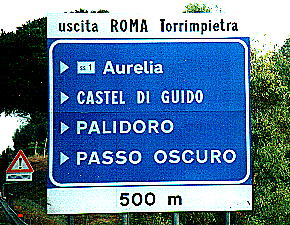
The fauna corresponds to cold climatic phases.
Although it seems a paradox, in this level of only 35 cm there are in secondary lying amygdales of the ancient Acheulean (dated between 700,000 and 430,000 years) and, above these, amygdales and artifacts of the middle Acheulean (dated around 430,000 years from now). ( see: " Guida alla preistoria italiana", edited by A.M. Radmilli; Sansoni Publisher, 1975) .
Other diggings at Torre in Pietra were made in 1978 (Piperno and Biddittu).
A cast of the Torre in Pietra excavation with amygdales, elephant tusks, etc. is on public display at the Luigi Pigorini Museum in Rome.
Castel di Guido and Malagrotta (Radmilli and Boschian digs, 1996). In these two sites, and in the Torre in Pietra site with the 1978 diggings, the evolved Acheulean was discovered, which is dated as being 300,000 years old.
The stone industry of Castel di Guido is associated with an industry on bone: these are tools made from the diaphyses of long bones of pachyderms; among these, there are also amygdaloid bifaces.
The site contains remains of elephant, horse, aurochs, megaceros, bear and deer ( see: " Introduzione al Paleolitico" A.Broglio, Laterza, Bari, 1998).
The zooanthropomorphic sculpture of Torre in Pietra has been found in a farmland and is attributed to the evolued Acheulean for typology.The surface search, in this zone, is particularly difficult, in how much is extremely rare the hard stone.
The territory is constituted by low hills, where even in the small streams it is difficult to find stones, and consequently paleolithic artifacts.
The Acheulean deposit of Torre in Pietra, excavated by A C. Blanc and by L .Cardini, is under 30,40 meters of earth, what indicates that all the Acheulean paleosoil of the zone has been covered from great quantities of earth. However, Acheulean artifact outcrops, although very rare, are also present on the surface, in the fields, but we cannot say that these are Paleolithic deposits.
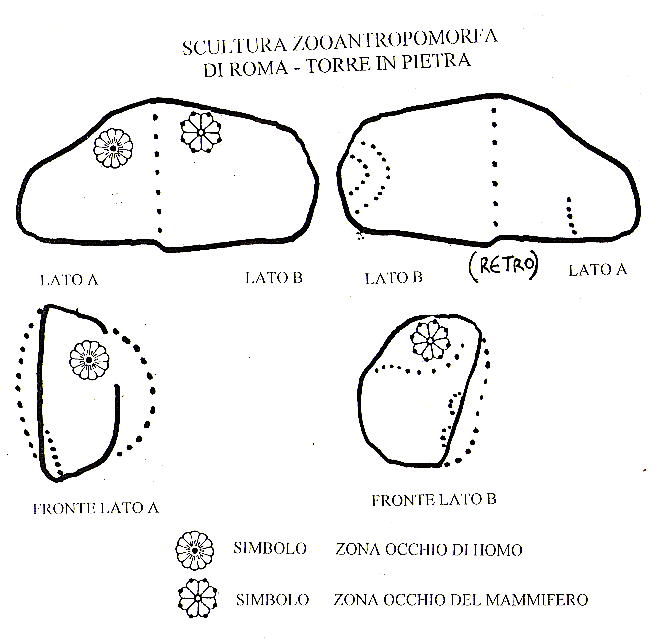
(Drawing to better interpret the photographs of the sculpture. The floral symbols indicate the eye, that must be imagined, as in the sculpture exists only a generic orbital zone, more evident in the mammal).
The head (side A) is of an evolved Acheulean man, and is in horizontal elongated style. (See Fig. 1)
The head (side B) is of an over-sized mammal. (See Fig. 1)
The sculpture on the back has no representation of the orbital zone, as it is prevalently flat. (See Fig. 3)
The human head (forehead side A) is semifrontal (See Fig. 4) ( see Fig. 4)
Also the head of the mammal (forehead side B) is semifrontal (See Fig. 5)
SCULPTURE DESCRIPTION
The sculpture represents a human head joined at the nack to a mammal head.
The sculpture is in hard stone, and is lightly damaged from alluvial tumbling, therefore a part of the working, that is the marks of material chipping, have been erased.The signs of the working that have remained, are visible under the jaw and to the two sides of the jaw of the man; other signs are on the posterior region of the snout of the mammal, while on the back the zone of the mouth is evidenced.
This sculpture is attributed to the evolued Acheulean for its shape, through the typology of the sculptures.
Dating300.000 years approximately.
Size: lenght cm 12,1, height cm 6.2, widht cm 4.8. Weight k. 0.460.
The human head has the same height of the mammal head, and this re-enters in the artistic invention, since the head of the mammal, presumably a rhinoceros, or a great ruminant, is well greater in reality of the human head.
It is necessary to consider that in the small zoomorphic stone sculpture of the Acheulean, the Mousterian, the Aurignacian and the Gravettian, the horns and the tusks were not represented, as it was impossible to realize them with the working techniques at the disposition of the man.
In the Gravettian of Dolni Vestonice (ca. 26,000 B C), the small terracotta rhinoceros heads, instead, have represented the horn, since this new processing technique allowed its realization.
The two heads are semifrontal, that is they represent each head laterally, while the frontal representation is a little wider of half; therefore the orbital zone is only one. The human head has evidenced in the opposite part a part of the jaw, while the head of the animal has evidenced a part of the mouth.
In the sculpture (Fig. 1), the two heads joined by the neck have look in opposite direction, but are a little oriented towards the observer of the photograph. Greater evidence of this disposition, is in the photo seen from above (Fig. 6), where is seen a squaring giving a curve. Moreover, this sculpture is not all the way around, but has the two heads semifrontal, in how much on the back it is mostly flat.
The setting of the human head has the solemnity of the remodeled skulls of Jericho, in how much the head or the skull, without the neck, has an inclination with look turned a little towards the sky.
The man of the evolued Acheulean (Homo erectus or archaic Homo sapiens) did not have the chin and had the escaping forehead; and the human type of this sculpture has these characteristics.
This human head has a stylistic deformation, defined "lengthened horizontal", that is at opposite of the style " lengthened vertical" present in the sculptures of successive civilizations, between which the heads of the cicladic idols that have also abolition of eyes and mouth.
The sculpture, generally, has a unique style in the bicephalic anthropomorphic representations, that is joining two human heads, but this from Torre in Pietra has TWO STYLES, one for the human head, and another for the mammal head.
The style of the human head is constituted from a greater lengthening and from the abolition of the orbital zone, i. e. from an accentuated idealization of the head shape.
The style of the head of the mammal is characterized by a strong realism, as the orbital area and the large lips, or if you like the mouth area, are represented. Obviously, in this analysis we must take into account the limits existing in the working technique, that is, the possibility of highlighting details, and also the cultural advances in the composition of the work itself. The analysis, therefore, focuses on what man has done, and what he could do.
Two different styles involve two different traditions.
In the evolved Acheulean originates the embellishment of tools such as amygdales, involving the elaboration of a form, which falls within the style.
The human head, in this case, has a harmonious elaboration of lengthened horizontal type with abolition of the orbital zone, evidently following an ideal of beauty.
However, the origin of the representation of the human head goes back to the Pebble Culture, and has, therefore, a tradition much more ancient than the representation of the animal heads, and this can involve a greater idealization, almost like the symbolization of the images.
The union of two different styles in the art applied to the ceramics is normal practice in the historical periods, where, to decorate , is applied a geometric style or a figurative style to the style of the shape of the ceramics , and however the styles can be simultaneously three and four, as they are cultural accumulations of different traditions.
In the representational art, like in this sculpture of Torre in Pietra, the union of two styles can be consequence of the religion, about which two hypotheses can be made:
- Considering that bicephaly in art is consequence of a people's religion, it can be hypothesize that two people, one with anthropomorphic sculpture, and the other with zoomorphic sculpture, and with different styles, are come in contact, joining their deities in the style practiced.
or:
- Considering that in the Acheulean the sculptures of human heads have been found in greater number, and with better quality than those of animals, it can be assumed that the main cult, and more ancient, is related to the human head, that was realized with a consolidated stylistic language, while the representations of animal heads have a realistic style, a little coarse, and without embellishments, in how much, being made rarely, there was not ability in making them.
Something similar, in the opposite sense, occurred later among the Magdalenians in France and Spain with their religion connected to animals. The Magdalenians were very skilled painters, and painted only animals; the very rare depictions of human beings are of very poor quality, as they, never making them, were not skilled in making them. Anyway, also the scarce quality of a new iconography must be attributed to a different style, although the quality is not a characteristic of the style, i. e. of the language of art.
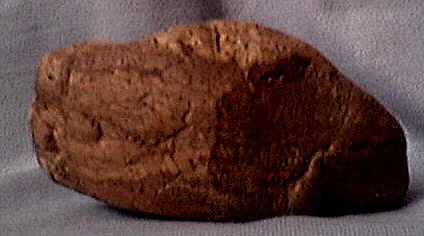
Back of the lateral view Fig. 1
This part is mostly flat, and it does not have indications of the orbital zone (see drawing Fig. 2).
The only intentional workmanship, for representational purpose, is a chipping that thins the man's jaw (side A), and a semicircular chipping in the area of the mammals mouth. (Chippings indicated in the drawings in Fig. 2).
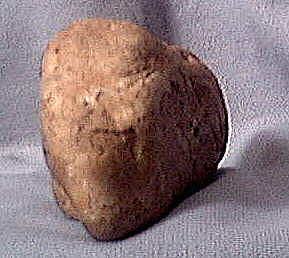
Frontal view of the man's head (side A).
The conception of the depiction is semi-frontal.
The drawing (Fig. 2) includes a floral symbol indicating the eye area.
The dotted lines at the edges of the drawing indicate the back of the human head, corresponding to the head of the mammal.

Frontal view of the mammal's head (side B).
The conception of the depiction is semi-frontal.
In the drawing (Fig. 2) is inserted a floral symbol indicating the zone of the eye, which is obtained at the top on the back of the muzzle.
The eye zone can also be seen well in the photograph Fig. 6, right side.
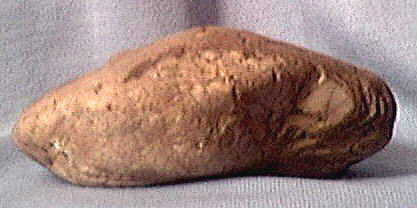
View from the top of the sculpture (Fig. 1).
On the left, the head of the man, on the right, the head of the mammal.
In this photograph you can see at the top the curved part where no representation of the orbital zone is present, i.e. the back.
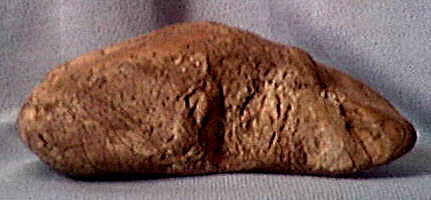
View from the bottom of the sculpture (See fig. 1).
On the left is the mammal head, on the right, the one of man.
In this photograph the curved part can be seen at the top, as in Fig. 6.
In the side on the right are visible signs of the chippings under and between the jaw of the man's head.
TYPOLOGY
The typology of the Paleolithic stone sculpture is not consolidated like the typology of the industries, that has been made by a great number of palethnologists, but is enough indicative as base for the research.
Some types of lithic sculptures are present from the beginning (Pebble Culture) to the end of the Paleolithic, others extinguish during the Paleolithic, others continue beyond the Paleolithic.
Some types of sculptures are present at the same time in a unique civilization.
Every type of sculpture has different style in the time and the space.
From the most ancient phases to the most recent ones, there is an increase of quality as a result of the improvement of processing techniques.
In the anthropomorphic sculpture are represented the several human types that have succeeded in the Paleolithic, and also these can be inserted in the typology.
In the Pebble Culture only sculptures of semi-frontal human heads are known.
Ssculptures of heads of mammals , and sculptures of bicephalic heads begin from the Abbevillian.
From the ancient and middle Acheulean bicephalic human heads have several shapes, between which the union of the jaws re-entering up, and the sculptures seem some " V " inverted.
From the evolued Acheulean sculpted divisions appear, similar to engravings, in order to distinguish two heads joined by the nape; and appears also the frontal representation of the face
In the evolued Acheulean there are human heads, with opened wide mouth, that are expressions of movement, in how much interpreted like representation of the shouting man.
From the middle Paleolithic, the sculptures of human heads are represented also with headgears and hairstyles.
From the beginning of the upper Paleolithic, through hats and hairstyles it is possible to distinguish man from woman.
The types of sculptures I have classified are as follows :
- human head without neck,
- head of animal without neck,
- two human heads joined by the nape,
- human head and head of animal joined by the nape,
- human head with neck,
- head of animal with horizontal body without limbs,
- human head with vertical body without limbs,
- head of animal with human vertical body without limbs,
- mixed head of man and animal
This typology refers to the lower and middle Paleolithic.
From the middle Paleolithic appear also sculptures with three and four human heads.
Always from the middle Paleolithic, in bicephalic anthropomorphic sculptures, one head may be bigger than the other, and with oriented in various directions.
In the middle Paleolithic appear, also, greater differences (for two different uses) between the sculptures that can be in vertical position, and those behind flat, that must be in horizontal position (I say this, because in photography cannot appreciate the difference).
From the middle Paleolithic increases the dimension of the sculptures, some human heads are biggerr than natural,, and have also the representation of eyes and mouth.
From the beginning of the Upper Paleolithic appears the small bicephalic anthropomorphic sculpture with human vertical body .
From the Upper Paleolithic begin, in parallel, also the productions of the smallest lithic sculptures.
In the evolued Acheulean the anthropomorphic and zooantropomorphic stone sculptures are of two types:
- two human heads joined by the nape,
- human head and joined by the nape head of animal .
The more frequent type is the sculpture of two human heads joined by the nape.
Next I will show with drawings and photographs the typologic affinities of these bicephalic types, with particular reference to the sculpture from Torre in Pietra.
The other types of stone sculptures of the evolued Acheulean are as follows:
- human head without neck,
- head of animal without neck,
- head of animal with horizontal body without limbs,
- head of animal with vertical body without limbs,
- mixed head man and animal.
The types that I have classified of the evolued Acheulean are seven.
The typology of a Paleolithic sculpture is consequence of a function, that can be considered of certainly religious type in the bicephalic sculptures, while CANNOT be considered of surely religious type the increase of the represented parts of the body, that is the passage from the single human head, to the human head with neck, and to the human head with vertical human body without limbs.
The typology I have indicated is useful like orientation in order to establish the great differences between a type and an other, but this does not mean that sculptures of same type are all equal, even if produced in a same period.
To analyze the many aspects of the typology, I have correlated the sculpture from Rome - Torre in Pietra with the sculpture from Maribo and with that from Rodi Garganico (see on this magazine: " A bicephalic anthropomorphic lithic sculpture of Lower Paleolithic of Denmark ", and " A bicephalic zooanthropomorphic lithic sculpture of the evolved Acheulean in Southern Italy "). They are three sculptures of the evolved Acheulean that are correlated in order to evidence affinities and differences.
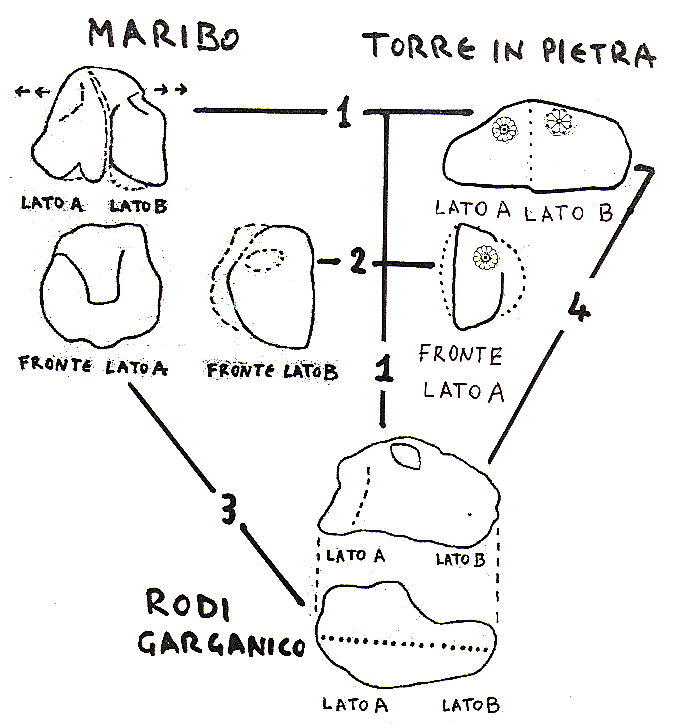
Affinities and more evident typological differences:
in the three sculptures the forehead of the man is receding (1).
The human heads from both Maribo and Torre in Pietra are semi-frontal (2), one on the right and one on the left.
The human heads from both Maribo and Torre in Pietra are semi-frontal (2), one on the right and one on the left.
The human heads from both Maribo and Torre in Pietra are semi-frontal (2), one on the right and one on the left.
The three sculptures on the back have no representation of the orbital zone
The sculpture of Maribo is in proportion to the real, in vertical sense; while the others two are of horizontal elongated type.
The human head (front side A) from Maribo is of frontal conception.
The human head from Rodi Garganico is semi-frontal, but with jaw of frontal conceiving.
The sculpture of Rodi Garganico has an eye in common to the head of the man and the head of the mammal.
The sculpture from Maribo has an engraving ( sculpted ) that divides the two human heads.
The styles are three for the four human heads, and one for the two heads of mammal.
CONCLUSION
The affinities and the more evident differences in the typology of the three sculptures from Torre in Pietra, Maribo and Rodi Garganico (Fig. 8) numerically are 17, but wanting to make an analysis more deepened, (that is not object of this paper), this number would become more than doubled.
In the typology no observation must be discarded to which we can give a meaning, even if minimal, in how much it can be used in order to interpret further new and old findings.
In the sculptures of human heads, nose is made in tens of ways; other heads have the cheekbones made in tens of ways, etc.
There are sculptures of human heads without noses or cheekbones, for stylistic deformation in a reductive sense.
Some of these typological remarks are useful for the research of the physical aspect of the man, in order to fill, at least as guideline, the periods in which skeletons have not been found, but also for the cultural attribution of the sculptures themselves. Other typologic remarks are useful for the chronological investigation through the styles.
Also the workmanship technique of the sculpture re-enters in the typology.
Every sculpture has an elevated number of typologic data to be compared with other sculptures, where the differences may be more than the affinities; but the affinities are the clue to follow in the investigation.
When I have found the sculpture of Torre in Pietra, I have attributed it immediately to the evolved Acheulean by experience; now having to give an explanation to the reader (that I hope becomes a future researcher), I try to reconstruct what I have thought in an instant, and I hope not to forget nothing:
1) I have other sculptures of the evolved Acheulean of horizontal lengthened type (bicephalic), and some are also longer and thinner. (Origin South Europe)
2) The horizontal lengthened type is not found, neither before, neither after the evolved Acheulean.
3) The style of the human head, without representation of the details of the face, is a variant of the lengthened horizontal type of the evolved Acheulean. (N.B. I have put in relation with the sculpture from Torre in Pietra the two sculptures from Maribo and Rodi Garganico, in how much on this magazine are published two of my papers about Maribo and Rodi Garganico).
4) Bicephaly does at this attribution not matter, as it was present before and after the evolved Acheulean.(Cultural evolution continues).
5) The semi-frontal setting of the head is not important in this attribution, in how much was present before and after the evolued Acheulean.( Cultural evolution continues.)
6) The back without representation is not considered in this attribution, in how much was present before and after the evolued Acheulean.(Cultural evolution continues).
7) The head of the mammal is identical to that from Rodi Garganico of the evolued Acheulean.
8) These heads of mammal are not present in sculpture, neither before neither after the evolued Acheulean.
9) These heads of mammal have the same style.
10) The escaping forehead of the human head is similar to that one of the sculptures from Maribo and Rodi Garganico, and others.
11) The shape of the human head, in spite of the stylistic deformation and the abolition of the features of the face, preserves the lateral profile of the head, from the zone of the nose to the jaw, that is reconducible to the man of the Acheulean, and that I have found also in other sculptures.
12) In this sculpture the two heads (human and animal) are slightly oriented towards the observer, like in the sculpture from Rodi Garganico, and in others.
13) The sculpture from Torre in Pietra has few traces of the original working, as they have been cancelled nearly totally from the alluvial tumbling, however, of what remains of the sculpted, together with the shape, all is riconducible to the evolued Acheulean. For shape it is meant the sum of the main aspects of the typology of a period.
To the current state of our knowledges, through the typology of the Paleolithic sculpture, I consider justified the attribution to the evolued Acheulean of the sculpture from Torre in Pietra.
The evolued Acheulean, at area of Torre in Pietra, is dated to 300,000 years.
Assuming that the evolued Acheulean in Italy has from 350,000 to 200,000 years, that is a length of 150,000 years, this must do to ponder on two opposite considerations; one amazing, concerning the slowness of the cultural progress, and the other garantist in support of the strong consolidation in the man of the activity of representation through the sculpture.
Copyright©2000-2002 by Paleolithic Art Magazine, all rights reserved.